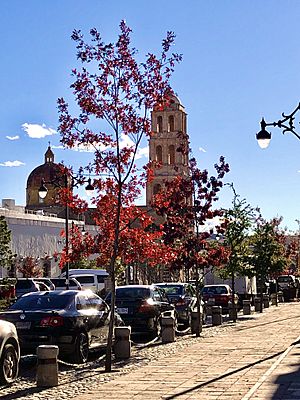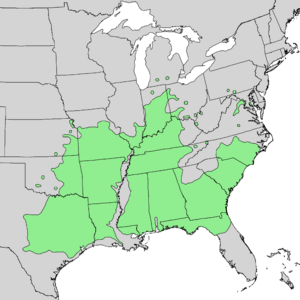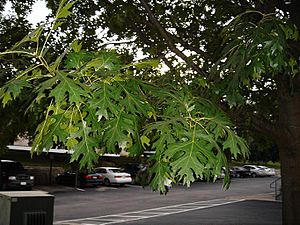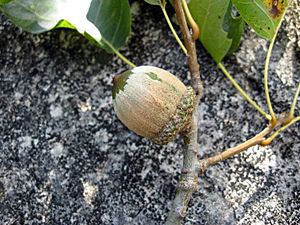Shumard oak facts for kids
Quick facts for kids Shumard oak |
|
|---|---|
 |
|
| Fall color of a planted tree in Sombrerete, Zacatecas, Mexico | |
| Conservation status | |
| Scientific classification | |
| Genus: |
Quercus
|
| Species: |
shumardii
|
 |
|
| Generalized natural range | |
| Synonyms | |
|
|
The Shumard oak (scientific name: Quercus shumardii) is a large and impressive tree. It's also known by other names like spotted oak or swamp red oak. This tree belongs to the red oak group, which is a big family of oak trees. It's quite similar to other red oaks like the Texas red oak and Nuttall's red oak.
Contents
Where Shumard Oaks Grow
The Shumard oak is naturally found in many parts of North America. It grows mainly along the Atlantic coastal plain, from North Carolina down to northern Florida. You can also find it stretching west into central Texas.
These trees also thrive in the Mississippi River Valley. They reach as far north as central Oklahoma, eastern Kansas, and Missouri. You can also spot them in southern Illinois, Indiana, western and southern Ohio, Kentucky, and Tennessee. Sometimes, they are even found in southern Michigan, southern Pennsylvania, Maryland, western New York, and the very south of Ontario, Canada.
What Does a Shumard Oak Look Like?
Shumard oaks are known for their impressive size. They can grow to be about 25 to 35 meters (80 to 115 feet) tall. Their main trunk can be 60 to 100 centimeters (2 to 3 feet) wide. The wide top part of the tree, called the crown, usually spreads out 12 to 18 meters (40 to 60 feet).
Some record-breaking Shumard oaks have been measured even taller. They can reach up to 60 meters (200 feet) in height. Their crowns can spread as wide as 27.5 meters (90 feet). Younger trees often have a cone or oval shape. As they get older, the top of the crown fills out more. The trunks are usually straight and grow upwards. Near the ground, the trunks might have deep ridges.
Shumard oaks often grow in low-lying areas. They are tough trees and can survive even if the soil is flooded for up to six weeks each year.
Bark of the Shumard Oak
When a Shumard oak is young, its bark is light gray and very smooth. It can even look shiny. As the tree gets older, the bark becomes darker. It also develops ridges and deep grooves. Sometimes, you might see white spots on the bark.
Twigs and Buds
The small branches, called twigs, of the Shumard oak have a cluster of buds at their tips. These buds are lighter in color than the olive-green twigs. Young twigs are also quite shiny.
Shumard Oak Leaves
The leaves of the Shumard oak grow one after another along the twig. They are wide and shaped like an upside-down egg. Each leaf has 5 to 9 lobes, and each lobe ends with a sharp, bristle-like point. The leaves grow to be about 10 to 21 centimeters (4 to 8 inches) long.
The top surface of the leaves is smooth and dark green. The bottom side is a slightly lighter shade of green. In the fall, the leaves change color. They turn brown to red, and sometimes have hints of yellow mixed in. These fall colors appear relatively late in the year. For example, trees in central Texas might be brightest red in early December. Trees in Florida might not show much color until February.
Acorns of the Shumard Oak
Shumard oaks produce fairly large acorns. These acorns can grow up to 3 centimeters (1 inch) across. It takes a long time for the acorns to fully grow. They need between 1.5 and 3 years to mature. Because of this, you might not notice them when they are first starting to develop.
Shumard Oak in Nature
The acorns from the Shumard oak are an important food source for many animals. Various songbirds and game birds, like wild turkey and quail, eat them. Waterfowl, white-tailed deer, and even feral hogs also enjoy the acorns. Many rodents, such as squirrels, rely on them too. White-tailed deer also eat the leaves and twigs of the Shumard oak.
Diseases Affecting Shumard Oaks
Like all red oaks, the Shumard oak can be attacked by Oak wilt. This is a serious disease. Other problems that can affect Shumard oaks include different types of fungi that grow on leaves. They can also get powdery mildew, canker diseases, and a problem called shoestring root.
How People Use Shumard Oaks
Shumard oaks are very useful trees. They are grown for their wood, as beautiful shade trees, and as a food source for many birds and mammals. These trees can grow well in many different types of soil. Because of this, they are planted far north in places like Ottawa, Ontario, and southern Quebec. They also grow far south in places like Lake Worth, Florida.
Shumard oaks can handle a wide range of soil acidity (pH levels). They are also good at surviving dry periods, known as droughts. They prefer to grow in partial or full sunlight. Shumard oaks start to produce seeds when they are at least 25 years old. They are best at making seeds when they are about 50 years old. These trees are known to live for a very long time, sometimes over 480 years! Their roots don't like to be disturbed. So, it's best to plant a young tree in its permanent spot early on.
Shumard Oak Wood
The wood from Shumard oaks is often grouped with other red oak wood. It is used to make flooring, furniture, and parts of a house's inside like trim and paneling. It's also used for cabinets. The wood from Shumard oak is considered stronger and better than wood from other red oaks.
See also
 In Spanish: Quercus shumardii para niños
In Spanish: Quercus shumardii para niños




